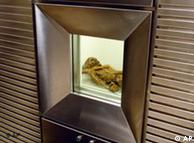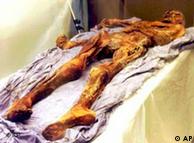A study released on Thursday suggests that Oetzi, a human
specimen found in the Alps of South Tyrol nearly two decades ago, was
not "frozen in time and place" following his death five millennia ago.
A team of Italian and American researchers now believe the Iceman
actually received a proper burial ceremony atop a mountain pass, months
after his death.
Oetzi was initially discovered in 1991 at the Tisenjoch Alpine pass
along the border between Austria and Italy. Researchers theorized that
the Iceman died of a battle-related arrow wound to the shoulder. It
followed that Oetzi's personal belongings were frozen with him after his
death in the upper reaches of the Alps.
Yet according to a new study published today in the journal
Antiquity, those conclusions were not based on detailed mapping of the
grave site.
A team of archaeologists, anthropologists and geo-specialists used
spatial analysis to pinpoint the distribution of the man's belongings
and the corpse itself - leading them to propose that his body was
ceremoniously placed on elevated rock, some five meters (about 16
feet) away from his eventual discovery site.
"We concluded that he died in April, and in April the pass was
probably full of snow," said Alessandro Vanzetti, an archaeologist at
the La Sapienza University of Rome and one of the study's authors.
"He couldn't have died on the spot, furthermore, he didn't die on this stone, as had been reported."
Botanical evidence
 Bildunterschrift: Großansicht des Bildes mit der Bildunterschrift: Researchers have not reached consensus on the circumstances of Oetzi's death
Bildunterschrift: Großansicht des Bildes mit der Bildunterschrift: Researchers have not reached consensus on the circumstances of Oetzi's death
The team analyzed pollen ingested by Oetzi before his death and
compared it with pollen found in the ice surrounding him, noting a
"mismatch" between his death in April - which the team suspected
occurred at a lower altitude - and his possible burial in August or
September.
Researchers concluded that the Iceman died in a different location, and that his body was recovered.
"We think he was kept in some kind of cellar," Vanzetti told Deutsche
Welle. Citing regional historical knowledge, the study noted that in
Oetzi's day, the dead were customarily placed in farmsteads called
"masi" before the winter snow and ice melted.
"It was used by people in Tyrol during the cold seasons," he said.
"When one was dead, it was impossible to bury immediately, because the
ground was frozen."
"He was a very important person, so people decided to bury him on the pass," Vanzetti added.
Luca Bondioli, co-author of the paper and an anthropologist with at
the National Museum of Prehistory and Ethnology in Italy, described
Oetzi as "an individual of the elite."
"The fact that we have a new interpretation of the discovery is
important," he said in an interview with Deutsche Welle. The study noted
that previous Oetzi research was based on the initial interpretation of
the Iceman find and his belongings as "frozen in time and place."
 Bildunterschrift: Großansicht des Bildes mit der Bildunterschrift: Scientists say the Iceman died from an arrow wound to the shoulder
Bildunterschrift: Großansicht des Bildes mit der Bildunterschrift: Scientists say the Iceman died from an arrow wound to the shoulder
Distribution data
But the team's findings suggested that the Iceman's personal effects
were carefully placed near his body during a burial ceremony, not simply
scattered around him as he lay dying.
"There is a strong indication that the distribution can be explained by gravity and movement in the ice," Vanzetti said.
The archaeologist and his colleagues proposed that Oetzi and his
grave goods were placed on an area of raised natural stone. Later on,
according to the study, "cyclical thawing and freezing" caused the
corpse and the burial items to shift.
The distribution was likely variable: lighter objects, such as hair
and Oetzi's quiver, did not move in the same way as more weighty items,
such as fur, leather and the body itself.
Lingering questions
Yet not all researchers in the field are prepared to accept the
burial theory. Albert Zink, who was involved in efforts to map Oetzi's
DNA and serves as head of the Institute for Mummies and the Iceman, said
the team's conclusion was "not very convincing."
"There there are
several things which I think are clearly in contrast to a burial," he
told Deutsche Welle, citing the unusual placement of the bow, which had
been stood upright, as well as the random distribution of Oetzi's
belongings. Moreover, the Iceman was found with his right arm in a
vertical position that Zink said would have been corrected before a
burial.
Nevertheless, the new
theory speaks to certain missing links in the Iceman story - including
why Oetzi was found with unfinished weaponry. It could also explain why
personal effects were discovered near his body, considering the
likelihood that his attackers would confiscate the belongings of a
felled opponent.
"Ultimately," the
study read, "the impressive array of other objects is better explained
as grave furnishings than as mountain equipment."
Author: Amanda Price
Editor: Cyrus Farivar
http://www.dw-world.de/dw/article/0,,5947330,00.html









